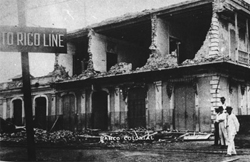The Science Behind Earthquakes
Submitted by Mónica Ivelisse Feliú-Mójer on
Two months ago we received 2010 with the news that neighboring Haiti was struck with a 7.0 magnitude earthquake. Not recovered from Haiti’s situation, in the last days of February, Chile also experiences an earthquake; this time an 8.8 one and nowadays they are still getting aftershocks. After all these events have you ever asked yourself what causes an earthquake? Can Puerto Rico be struck by an earthquake? Fortunately, the answers to all these questions and the science behind earthquakes are the focus of the research of geologists like Dr. Daniel Laó Dávila and the Puerto Rico Seismic Network.
Dr. Laó Dávila, a CienciaPR.org member, graduated from the University of Puerto Rico at Mayaguez, Department of Geology. Later on, he continued post-graduate studies completing a master in geology from Florida International University and a Ph.D. in the same field from the University of Pittsburgh. Currently, he is a Research Associate at the Puerto Rico Seismic Network. The Puerto Rico Seismic Network is part of the Department of Geology of the University of Puerto Rico at Mayaguez. Its mission is to detect, prosecute and investigate the seismic activity in the region of Puerto Rico and to report opportunely the results for purposes of public security, education, engineering and scientific research.
Puerto Rico in the past has been struck by big earthquakes because it is located in the border of the Caribbean and North American plates. On October 11th, 1918 an earthquake with a main-shock epicenter in the Mona Passage and a magnitude of 7.3 destroyed buildings in the west of the Island and also triggered a devastating tsunami. Thanks to researchers like Dr. Laó Dávila, the Island seismicity is investigated and monitored.
His research is focused in understanding the tectonic motion between the Caribbean and the North American plates that are the responsible for the seismic activity in Puerto Rico. The tectonic plates are pieces of the Earth's crust and uppermost mantle. Earthquakes, volcanic activity, mountain-building, and oceanic trench formation occur as the result of tectonic plate interaction. Did you know that the Caribbean plate moves approximately 20 mm annually breaking rocks from the north Caribbean?
From the study of the tectonic motion in Puerto Rico, Dr. Laó Dávila has investigated the deformation of different rocks from west Puerto Rico using paleostress analyses (the orientation of the forces applied to the rocks through time) and paleomagnetism (the record of the Earth's magnetic field preserved in various magnetic minerals through time) along with structural geology techniques applied in the field and lab. These studies have helped improving our knowledge about the tectonic history of our Island and the Caribbean. In addition, tectonic faults within the island have been studied using GPS systems and seismicity to try to understand the current tectonic framework and to delineate the seismic risk for Puerto Rico.
Thanks to these research efforts we count with a lot of scientific data about earthquakes. However, to be ready for an earthquake is of everyone’s concern and we need to be prepared. If you would like to know about how to prepare and what to do in case of an earthquake, please go to the Federal Emergency Management Agency (FEMA) or the Red Cross websites for more info. Be aware that this is an unpredictable event and you need to know ahead of time how to prepare for an emergency.
If you would like to know more about earthquakes and Dr. Daniel Laó Dávila’s research please visit his profile at CienciaPR.org or the web site of the Puerto Rico Seismic Network that contains detailed information about the seismic events in our Island.








